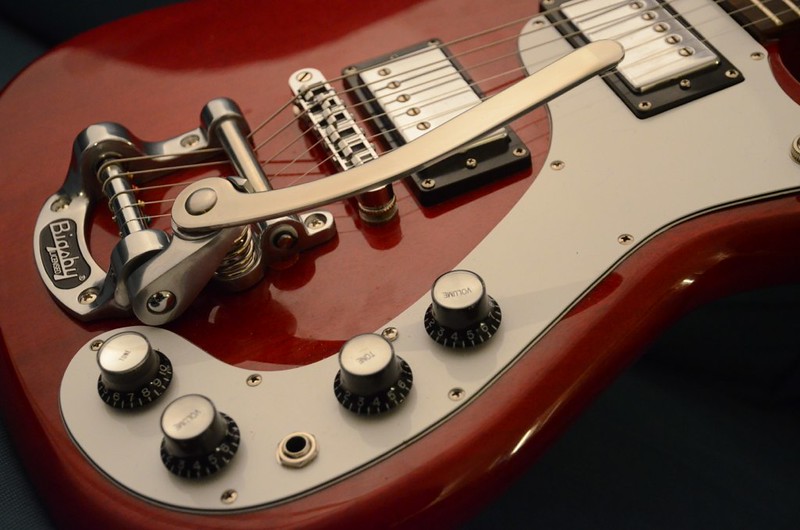The story of 1961 Epiphone Wilshire guitar
The history of Epiphone
Today, we associate the name Epiphone primarily with an inexpensive line of guitar copies of Gibson’s parent company. But that wasn’t always the case. By the 1930s, Epiphone had worked its way up to become a leader in guitar manufacturing, particularly in the construction of archtop guitars, and was engaged in a constant battle with its rival at the time, Gibson.
The company name originates from a combination of the call name of the then managing director Epi Stathopoulo and the Greek word for sound “phone”. This name had gained an enormous reputation in a short time. Since its foundation in 1928, the Epiphone company developed into one of the leading manufacturers for stringed instruments: initially for mandolins and banjos, and with the emerging new trends in jazz in the 1920s also for guitars, electric guitars and double basses.
When the Chicago Musical Instruments group, which also included the traditional manufacturer Gibson, was able to take over Epiphone Incorporation in 1957, Gibson boss McCarty killed two birds with one stone.
In the 1930s, Epiphone had developed into a serious competitor for the American market leader Gibson with Epaminondas “Epi” Stathopoulo. There was a battle for top positions in upscale guitar manufacturing, which was reflected in the time’s representative archtop guitars’ ever-larger body dimensions. For example, Epiphone’s top model Zephyr Emperor Regent competed with an immense body width of 18 ½ inches against Gibson’s 18-inch Super 400 (also interesting: Electric Guitar Combos).
The brutal competition was brought to a head by Stathopoulo’s untimely death from leukemia in 1943. Epi’s brothers Orphie and Frixo continued to run the company successfully, and they continued to build respectable acoustic and electric guitars. But there was a lack of foresight.
In 1951, a strike lasting several months put the company in dire financial straits. Epiphone then struck sail in New York and moved its headquarters to Philadelphia. However, the company couldn’t free itself from the difficulties. With the death of Frixo Stathopoulo in 1957, the once-proud Epiphone Incorporation’s independence came to an end.
For $20,000, not only did the venerable Epiphone name go to Gibson, but the deal also included the complete inventory: all finished and unfinished products, tools, machinery and stock. McCarty moved the entire company to Kalamazoo, where Epiphones were built side-by-side with the Gibson lines’ guitars. As early as 1958, a catalog of Epiphone Electrics and Acoustics was released.
Although models like Broadway, Emperor and Zephyr were still listed, it was also a swan song to the tremendous Epiphone archtop guitars. Competitors borrowed all other designs from Gibson’s Solidbody and Thinline models. From today’s point of view, it is worth noting that although we are dealing with a B-line, all instruments were manufactured as A-quality with identical tonewoods and all other components as the Gibson models.
However, only those guitars that were played by the Beatles made it to some prominence among the 60s models: a Thin-Line called ‘Casino’ and the ‘Texas’ flat top acoustic. Simultaneously, many Epiphones can compete with the Gibsons. The Sheraton model even surpassed its counterpart ES-355 in terms of luxurious equipment.
B-LINE’s BUILT-IN QUALITY
The Epiphones of the late 50s to mid-60s are high-quality instruments, comparable to the Gibson models in every respect. However, Gibson kept the full sized humbuckers for its own models and often equipped the Epiphones with the mini-humbuckers, which eventually made it into such iconic Gibson designs as the Firebird.
While the Thin-Line Casino model equipped with P-90 pickups was virtually identical to its Gibson counterpart ES-330 in terms of overall appearance, the Solid-bodys obviously emphasized formal independence. Nevertheless, the differences to the corresponding Gibson designs are within a narrow range. An excellent example for the business policy “similar but different” is the Epiphone model Wilshire (introduced in 1959), which Gibson presented as a counterpart to the Les Paul Special.
The 1961 example presented on these pages is in perfect condition with the original components. This is remarkable because for parts like the old P-90 pickups, the ABR-1 bridge and the lightweight aluminum tailpiece (the latter are identical to those of the original Les Paul Standard) alone, you often pay more than for the complete instrument.
The present Wilshire shows immediately what such a ‘Plane Jane’ model is capable of doing electrically. The construction of a mahogany body with a glued-in mahogany neck plus a Rio rosewood fingerboard together with highly sought-after hardware components provides the best acoustic basis for this. The powerful P-90 pickups strikingly translate the guitar’s intense vibrational characteristics into tight and sparkling fresh sounds, which produce wonderfully raw and drizzling electric tones – a real rock beast!
They built only 243 copies of the Epiphone Wilshire’s early version with large 3+3 headstock and Soapbar P-90 pickups. This makes the model one of the rarest Kalamazoo-produced guitars ever. In 1963, the design already received the famous Batwing head, a slightly modified body shape with a protruding horn on top and two mini-humbucker pickups. The early P-90 versions, although played by Hendrix, Townshend and Marriot among others, are not exactly at the forefront of the public’s interest at the moment. Prices on the vintage market occasionally start at $4500, but they can reach twice that amount in the best condition.
Bonus. What was the most successful hit played with an Epiphone?
The biggest Epiphone’s hit landed unexpectedly and almost by accident at the end of ’64. Paul McCartney had heard the guitar at the concert of B.B. King and also wanted something like that. So it happened that the extremely popular Beatles performed with Epiphone electric guitars. ‘Yesterday’, the most successful song in pop history, was also recorded by Paul in 1965 with an Epiphone Texan flat top guitar. Since we saw the Beatles with different guitars at that time, the hoped-for identification of them with Epiphone guitars did not occur.

